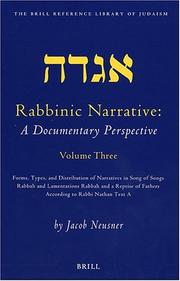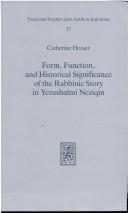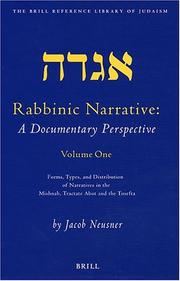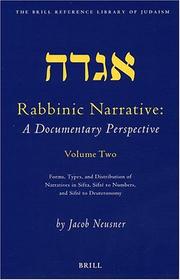| Listing 1 - 6 of 6 |
Sort by
|

ISBN: 9004130357 9004494545 142372965X 9781423729655 Year: 2003 Volume: 16 3 Publisher: Leiden Boston Brill
Abstract | Keywords | Export | Availability | Bookmark
 Loading...
Loading...Choose an application
- Reference Manager
- EndNote
- RefWorks (Direct export to RefWorks)
Each Rabbinic document, from the Mishnah through the Bavli, defines itself by a unique combination of indicative traits of rhetoric, topic, and particular logic that governs its coherent discourse. But narratives in the same canonical compilations do not conform to the documentary indicators that govern in these compilations, respectively. They form an anomaly for the documentary reading of the Rabbinic canon of the formative age. To remove that anomaly, this project classifies the types and forms of narratives and shows that particular documents exhibit distinctive preferences among those types. This detailed, systematic classification of Rabbinic narrative supplies these facts concerning the classification of narratives and their regularities: [1] what are the types and forms of narrative in a given document? [2] how are these distinctive types and forms of narrative distributed across the canonical documents of the formative age, the first six centuries C.E.? The answers for the documentary preferences are in Volumes One through Three, for the Mishnah-Tosefta, the Tannaite Midrash-compilations, and Rabbah-Midrash-compilations, respectively. Volume Four then sets forth the documentary history of each of the types of Rabbinic narrative, including the authentic narrative, the ma'aseh and the mashal. How the traits of the several types of narratives shift as the respective types move from document to document is spelled out in complete detail. This project opens an entirely new road toward the documentary analysis of Rabbinic narrative. It fills out an important chapter in the documentary hypothesis of the Rabbinic canon in the formative age.
Book
ISBN: 1463222815 9781463222819 1617191590 Year: 2010 Publisher: Piscataway, NJ
Abstract | Keywords | Export | Availability | Bookmark
 Loading...
Loading...Choose an application
- Reference Manager
- EndNote
- RefWorks (Direct export to RefWorks)
The Rabbis’ King-Parables: Midrash From the Third-Century Roman Empire examines the ancient Rabbis at work using parables about kings; parables that reflect the Rabbis' ideas about the role of the ruler in society, and the relationship of humanity to God. It considers the parables as resistance literature in light of the work of theorists of dominated groups. It is the first systematic attempt to read the parables as sources for Roman history in over 100 years.
Parables in rabbinical literature. --- Kings and rulers in rabbinical literature. --- Midrash --- Jews --- Judaism --- God (Judaism) --- History and criticism. --- History --- Love --- Jesus Christ --- Parables. --- Rome --- Palestine

ISSN: 07218753 ISBN: 3161461487 9783161461484 Year: 1993 Volume: 37 Publisher: Tübingen: Mohr,
Abstract | Keywords | Export | Availability | Bookmark
 Loading...
Loading...Choose an application
- Reference Manager
- EndNote
- RefWorks (Direct export to RefWorks)
Narration in rabbinical literature --- Parables in rabbinical literature --- Talmud Yerushalmi --- Criticism, interpretation, etc --- 296*23 --- Rabbinical literature --- Narration (Rhetoric) --- Talmudcommentaren --- 296*23 Talmudcommentaren --- Narration in rabbinical literature. --- Parables in rabbinical literature. --- Talmud Yerushalmi. --- Criticism, interpretation, etc. --- Nezikin (Talmud Yerushalmi) --- Neziqin (Talmud Yerushalmi)

ISBN: 9004130233 9786610467457 1423712307 1280467452 9047402200 9781423712305 9789047402206 9789004130234 Year: 2003 Volume: 15 2 Publisher: Leiden Boston Brill
Abstract | Keywords | Export | Availability | Bookmark
 Loading...
Loading...Choose an application
- Reference Manager
- EndNote
- RefWorks (Direct export to RefWorks)
Each Rabbinic document, from the Mishnah through the Bavli, defines itself by a unique combination of indicative traits of rhetoric, topic, and particular logic that governs its coherent discourse. But narratives in the same canonical compilations do not conform to the documentary indicators that govern in these compilations, respectively. They form an anomaly for the documentary reading of the Rabbinic canon of the formative age. To remove that anomaly, this project classifies the types and forms of narratives and shows that particular documents exhibit distinctive preferences among those types. This detailed, systematic classification of Rabbinic narrative supplies these facts concerning the classification of narratives and their regularities: [1] what are the types and forms of narrative in a given document? [2] how are these distinctive types and forms of narrative distributed across the canonical documents of the formative age, the first six centuries C.E.? The answers for the documentary preferences are in Volumes One through Three, for the Mishnah-Tosefta, the Tannaite Midrash-compilations, and Rabbah-Midrash-compilations, respectively. Volume Four then sets forth the documentary history of each of the types of Rabbinic narrative, including the authentic narrative, the ma'aseh and the mashal. How the traits of the several types of narratives shift as the respective types move from document to document is spelled out in complete detail. This project opens an entirely new road toward the documentary analysis of Rabbinic narrative. It fills out an important chapter in the documentary hypothesis of the Rabbinic canon in the formative age.
296*16 --- 296*16 Joodse bijbelwetenschap--(middeleeuwse en moderne) --- Joodse bijbelwetenschap--(middeleeuwse en moderne) --- Narration in rabbinical literature. --- Rabbinical literature --- History and criticism. --- Midrash --- Parables in rabbinical literature. --- Mishnah --- Criticism, Narrative.

ISBN: 1280467487 9786610467488 1423711947 9047402235 9781423711940 9789047402237 9789004130340 9004130349 Year: 2003 Publisher: Leiden Boston Brill
Abstract | Keywords | Export | Availability | Bookmark
 Loading...
Loading...Choose an application
- Reference Manager
- EndNote
- RefWorks (Direct export to RefWorks)
Each Rabbinic document, from the Mishnah through the Bavli, defines itself by a unique combination of indicative traits of rhetoric, topic, and particular logic that governs its coherent discourse. But narratives in the same canonical compilations do not conform to the documentary indicators that govern in these compilations, respectively. They form an anomaly for the documentary reading of the Rabbinic canon of the formative age. To remove that anomaly, this project classifies the types and forms of narratives and shows that particular documents exhibit distinctive preferences among those types. This detailed, systematic classification of Rabbinic narrative supplies these facts concerning the classification of narratives and their regularities: [1] what are the types and forms of narrative in a given document? [2] how are these distinctive types and forms of narrative distributed across the canonical documents of the formative age, the first six centuries C.E.? The answers for the documentary preferences are in Volumes One through Three, for the Mishnah-Tosefta, the Tannaite Midrash-compilations, and Rabbah-Midrash-compilations, respectively. Volume Four then sets forth the documentary history of each of the types of Rabbinic narrative, including the authentic narrative, the ma'aseh and the mashal. How the traits of the several types of narratives shift as the respective types move from document to document is spelled out in complete detail. This project opens an entirely new road toward the documentary analysis of Rabbinic narrative. It fills out an important chapter in the documentary hypothesis of the Rabbinic canon in the formative age.
Midrash --- Narration in rabbinical literature. --- Parables in rabbinical literature. --- Rabbinical literature --- History and criticism. --- Mishnah --- Mishna --- Mishnayot --- Mischnajot --- Mischna --- Mishne --- Michnah --- Mišnâh --- Mišna --- Mishnayoth --- Mishno --- Criticism, Narrative. --- Shishah sidre Mishnah --- משנה --- ששה סדרי משנה --- משניות
Book
ISBN: 3161611578 9783161611575 3161611586 9783161611582 Year: 2022 Publisher: Tübingen Mohr Siebeck
Abstract | Keywords | Export | Availability | Bookmark
 Loading...
Loading...Choose an application
- Reference Manager
- EndNote
- RefWorks (Direct export to RefWorks)
"This volume aims to broaden our understanding of the related genres of parables, fables, and similes in the Graeco-Roman world. These genres, which make use of narrative analogy, appear in early Christian and ancient Jewish literatures and in various Graeco-Roman sources. However, despite the fact that these texts were part of the wider cultural context of Graeco-Roman antiquity, they have not yet been thoroughly studied in relation to each other. The present volume brings together contributions on a range of Graeco-Roman, Jewish, and Christian sources, so as to contribute to the study of parables, fables, and similes across disciplinary boundaries. The contributions highlight the fluid boundaries between these different genres, but also demonstrate how their adoption and adaption in different literary works give expression to the distinct identities of the composers."--
Parables --- Parables in rabbinical literature --- Fables --- Simile --- Literary form --- 292 --- 225.08*7 --- 225.08*9 --- 225.08*9 Theologie van het Nieuw Testament: relatie met het hellenisme --- Theologie van het Nieuw Testament: relatie met het hellenisme --- 225.08*7 Theologie van het Nieuwe Testament: relatie met het jodendom --- Theologie van het Nieuwe Testament: relatie met het jodendom --- 292 Godsdiensten van Grieken en Romeinen. Klassieke mythologie --- Godsdiensten van Grieken en Romeinen. Klassieke mythologie --- 292 Religions des Grecs et des Romains. Mythologie classique --- Religions des Grecs et des Romains. Mythologie classique --- 292 Religions of the Greeks and Roman. Classical mythology --- Religions of the Greeks and Roman. Classical mythology --- Didactic literature --- Exempla --- Fiction --- Homiletical illustrations --- Legends --- Literature --- Tales --- Allegories --- Rabbinical literature --- Parabole --- Figures of speech --- History --- Bible --- Ba-yon Tipan --- Bagong Tipan --- Bible. --- Jaji ma Hungi --- Kainē Diathēkē --- New Testament --- Nouveau Testament --- Novo Testamento --- Novum Testamentum --- Novyĭ Zavet --- Novyĭ Zavi︠e︡t Gospoda nashego Īisusa Khrista --- Novyĭ Zavit --- Nuevo Testamento --- Nuovo Testamento --- Nye Testamente --- Perjanjian Baru --- Dhamma sacʻ kyamʻʺ --- Injīl --- Criticism, interpretation, etc. --- Parables. --- Parables in rabbinical literature. --- Fables. --- Simile. --- Rabbinic Judaism --- To 1500
| Listing 1 - 6 of 6 |
Sort by
|

 Search
Search Feedback
Feedback About UniCat
About UniCat  Help
Help News
News